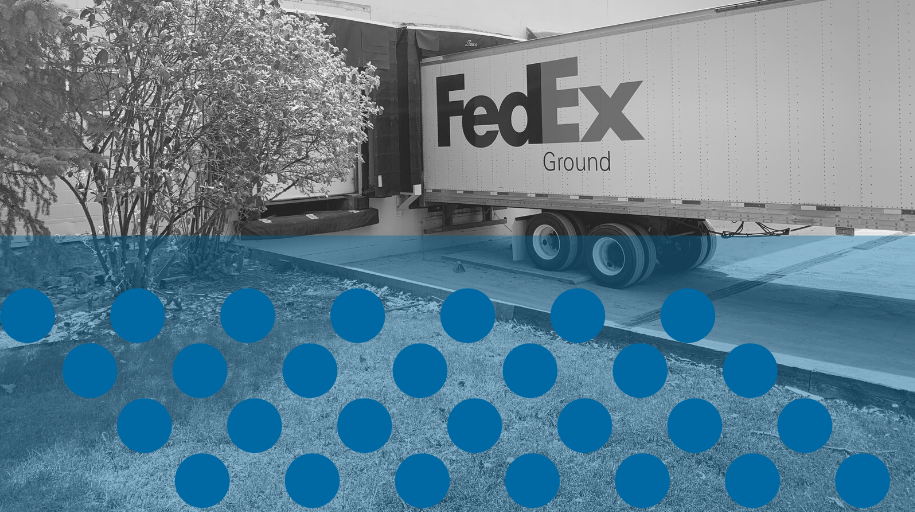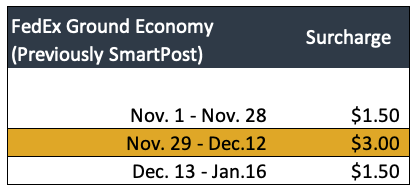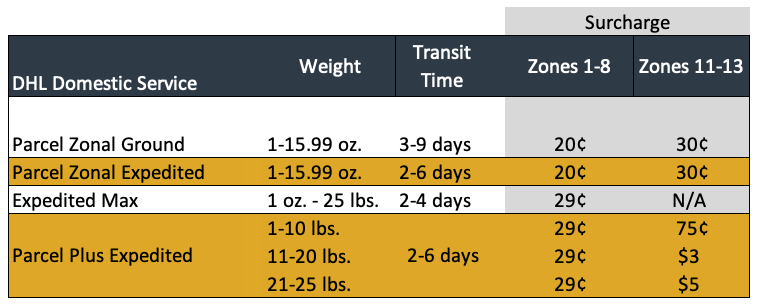
eFulfillment Service Reduces Expedited Shipping Rates for Clients
DHL and FedEx have added surcharges to holiday parcel shipping rates again for the 2021 holiday gift season, following the announcement of the U.S. Postal Service to repeat it’s surcharges from 2020. Ecommerce retailers will undoubtedly adjust prices or shipping charges to accommodate the new fees.
FedEx only applies surcharges to Ground Economy (formerly SmartPost) service, which no longer uses the U.S. Postal Service to deliver the last leg of a parcel’s journey to the consumer. (See SmartPost update at the bottom of this article.) Those charges start November 1, and carry through the holiday gift season, all the way to January 16th. Charges at the beginning and end of the season are $1.50, rising to $3.00 during the peak weeks of Nov. 29 to Dec. 12th.

DHL applies surcharges to several domestic and international services, starting as early as Oct. 3rd and running through Christmas Day, December 25th. For packages traveling 8 zones or less, surcharges range 20¢ to 29¢. For parcels traveling farther, zones 11-13, surcharges range from 30¢ to $5. eFulfillment Service clients primarily ship less than 8 zones, averaging well within DHL’s 29¢ surcharge parameters.

DHL’s International surcharges apply to both packet and parcel services evenly, adding $0.10 to each.

“We’re constantly examining our services, software and systems with the success of our clients in mind,” says Linda Sorna, Client Care Manager. “And we’ve made several improvements in anticipation of the holidays, …”
eFulfillment Service announced reduced rates on expedited services for its clients, which started August 9, 2021. The company, like much of the industry expected carriers to repeat holiday surcharges from last year. And despite those additional charges, eFulfillment Service is anticipating another season of peak order volumes and carrier delays.
“We’re constantly examining our services, software and systems with the success of our clients in mind,” says Linda Sorna, Client Care Manager. “And we’ve made several improvements in anticipation of the holidays, from increased wages, more robust recruiting plans, cross-training and redesigned workflows for speed and accuracy.”
Unlike many third-party logistics (3PL) companies, which have implemented invoice minimums or high order volumes to discourage smaller accounts, eFulfillment Service is open to startups, entrepreneurs or international companies launching in the U.S. Ecommerce retailers benefit from working with a professional fulfillment center in the following ways:
- With the combined shipping volume of all its clients, 3PLs can negotiate improved shipping rates, and pass those savings on to clients, like eFulfillment Service did with expedited rate reductions.
- Growing ecommerce retailers, trying to fulfill orders themselves, may have holiday sales above their shipping ceilings with carriers. Orders beyond those limits sit on the dock until the next day, while the customer waits. Professional fulfillment centers negotiate generous volume levels and can easily accommodate the holiday peaks of their full client list.
- Real-time automated inventory systems allow ecommerce retailers to sell on several marketplace platforms, like their own website, Walmart and eBay, without unknowingly selling an out-of-stock item.
United States Postal Service (USPS) also announced surcharges with two important changes this year versus last year.
FedEx Ground Economy Takes Over FedEx SmartPost
In March of 2021, FedEx completed the transition of its SmartPost delivery using the USPS. The transition started in May of 2020, but was delayed by repercussions of the COVID pandemic. Now all packages that could have used SmartPost, more than 3 million packages per day at its peak, use FedEx’s network, branded under the service FedEx Ground Economy. For customers, the conversion of the last mile delivery from the USPS to FedEx’s residential delivery service provides enough volume for FedEx to begin offering Sunday delivery options.




0 Comments